Friday, 26 June 2009, De Gaulle, and I don't mean the airport
Written 11 July 2009
Friday's plan was to visit the Army Museum so see the new exhibit on the life and work of Charles de Gaulle, which will be a permanent part of the museum's displays—another item David learned of in listening to Champs Elysées ("La France en cassettes!"), a sort of audible monthly news magazine that we subscribe to (and which has done amazing things for David's French comprehension; you can also get it on CDs now). The museum is located in the Invalides (easy walking distance from the Relais Bosquet) and is so large that, the first time we visited, a few years ago, tickets were good for two days; they knew you couldn't see all of it in one.

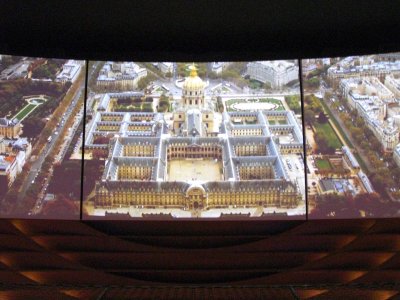 The Invalides is a huge complex (it has, count 'em, 15 interior courtyards) built in the 17th century by Louis XIV as a veterans' hospital and retirement home (hence its official name "hôpital des invalides"). It was suburban at the time but is now pretty much in the middle of the city, between the Eiffel Tower and the Louvre. Louis included both a full-size church (St. Louis des Invalides), at which daily attendance was compulsory for the veterans, and a private chapel for his own use, under the large dome. The view on the left is of the dome, regilded in 1989 for the bicentennial of the revolution, as we saw it when approaching on foot, on the inland side. The one on the right, taken from the river side, is from a film we were shown in the De Gaulle exhibit. (The keyhole-shaped green space at the left edge of the aerial view is the garden of the nearby Rodin museum, well worth a visit as well.)
The Invalides is a huge complex (it has, count 'em, 15 interior courtyards) built in the 17th century by Louis XIV as a veterans' hospital and retirement home (hence its official name "hôpital des invalides"). It was suburban at the time but is now pretty much in the middle of the city, between the Eiffel Tower and the Louvre. Louis included both a full-size church (St. Louis des Invalides), at which daily attendance was compulsory for the veterans, and a private chapel for his own use, under the large dome. The view on the left is of the dome, regilded in 1989 for the bicentennial of the revolution, as we saw it when approaching on foot, on the inland side. The one on the right, taken from the river side, is from a film we were shown in the De Gaulle exhibit. (The keyhole-shaped green space at the left edge of the aerial view is the garden of the nearby Rodin museum, well worth a visit as well.)
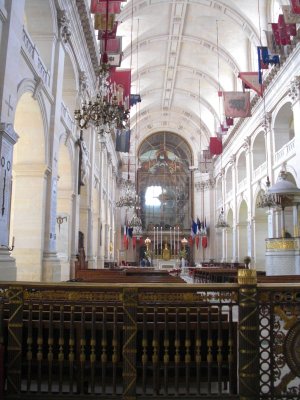 Nowadays, the complex divided up into several uses. Part of it (far right corner in the aerial view) is still a veterans' hospital. St. Louis is still a church, but I don't know whether services are still conducted regularly there or whether attendance is still compulsory. The chapel under the dome now houses Napoleon's grandiose tomb and those of some other war heros. The rest is divide between the enormous army museum and the museum of contemporary history. I'm not sure which the De Gaulle "historial" is part of. The largest courtyard, in the center, is the location of the hysterical abduction-of-the-bride scene, with the horse guards and the helicopter, in the finale of The Mad Adventures of Rabbi Jacob. Netflix must surely have it.
Nowadays, the complex divided up into several uses. Part of it (far right corner in the aerial view) is still a veterans' hospital. St. Louis is still a church, but I don't know whether services are still conducted regularly there or whether attendance is still compulsory. The chapel under the dome now houses Napoleon's grandiose tomb and those of some other war heros. The rest is divide between the enormous army museum and the museum of contemporary history. I'm not sure which the De Gaulle "historial" is part of. The largest courtyard, in the center, is the location of the hysterical abduction-of-the-bride scene, with the horse guards and the helicopter, in the finale of The Mad Adventures of Rabbi Jacob. Netflix must surely have it.
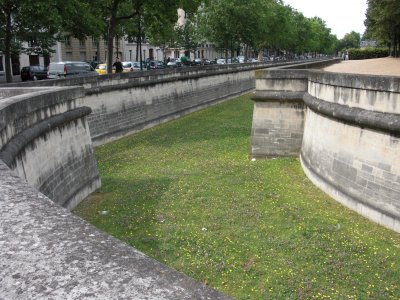 We entered the building just to the right of the dome (you can only get in a couple of ways, because most of the complex is surrounded by this picturesque dry moat, full of blooming yellow hawkweed that day), then hiked the length of the building, to the near left corner of the largest courtyard, then down a flight of stairs to the De Gaulle exhibit. We had the show almost to ourselves; only about three other people came and went while we were there.
We entered the building just to the right of the dome (you can only get in a couple of ways, because most of the complex is surrounded by this picturesque dry moat, full of blooming yellow hawkweed that day), then hiked the length of the building, to the near left corner of the largest courtyard, then down a flight of stairs to the De Gaulle exhibit. We had the show almost to ourselves; only about three other people came and went while we were there.
At the entrance to the exhibit, you are issued a set of headphones and what they call an audioguide (in the language of your choice), included in the price of the ticket, but the guide doesn't work like those in most museums. Usually, all the audio tracks are stored in the guide itself, and when you come to something that interests you, you punch in its number to hear more about it, so you can move through the displays at your own pace and in any order. In the De Gaulle exhibit, though, your guide is only a receiver. Each item in the exhibit has its own audio track and transmitter, so your guide plays to you the audio from whatever you're standing next to. It doesn't even have a volume control. If you're the first person in a while to approach an item, its audio is triggered and starts at the beginning; if others then join you next to it, their receivers pick up the audio at whatever point you've reached, and they must listen all the way through and start over to hear the beginning. Some items, especially the videos, just run continuously so you almost always start in the middle. The system has a few other disadvantages. For example, while listening to an audio track, you must stand rooted to the spot. The items are so close together that if you move two steps, your receiver will drop that signal and pick up a different one—much harder on the feet than being able to stroll around looking for other interesting items while you listen to the end of the one you've chosen. At first, looking mainly at still photos of De Gaulle's childhood, we couldn't imagine why the designers thought this system an improvement, but as we found how much of the exhibit consists of video, we started to see that—for those items—no other system would work. The audio had to stay in synch with the film. The more I think about it, though, the clearer I find it that the culmination of this approach is for the entire exhibit to be done in virtual reality. Each visitor would simply lie back in a comfy chair and "stroll" virtually through the rooms, selecting items to watch and listen to, all of which could begin and end on demand for every visitor. It's not as though, currently, you can really share items with your companions, since you're all isolated under headsets, continually listening to audio tracks that make comment and conversation difficult.
The designers did do a good job of breaking up what could have been the monotony of looking at photos, watching videos, and listening to narration. Some of the video was projected on spheres (and the picture cleverly distorted so that the curvature brought it back into the proper proportions). Some, both slides and video, was projected on the ceilings or floors without audio, just as background. Some ran on TV screens set in the wall. At intervals, a film was run in a central auditorium. Some information (again, photos and video with accompanying audio tracks) was projected on a large (table-sized) open book, and you could leaf through the chapters, forward or backward, by sweeping your hand across it as though turning pages. Period posters were displayed on large double-sided frames that you could pull out of the wall like giant vertical drawers, so many more could be available than could have been posted on fixed walls. In a little three-dimensional "shadow theatre" behind glass, a holographic projection of an actor reenacted clips from some of the general's most famous press conferences. On two or three giant video screens were projected nested menus of topics. To use one, you stood ("one personal at a time, please; all others stay outside the circle") at a designated spot and pointed at the screen. Two seconds of continuous pointing was counted as a click, and that item opened, either starting a video/audio sequence or presenting another set of choices. Unfortunately, the screen I was most interested in—the history and sociology of the 1968 Paris riots—didn't work very well. The cursor didn't respond consistently, and the menu choices floated around on the screen like a screen saver, so that just as you were pointing for all you were worth and managing to inch the cursor toward the one you wanted, that icon would drift serenely away sideways. (When I mentioned the problem to the front desk as we were leaving for the day, they said, "oh, yes, you have to take a step forward; they painted the circle on the floor a little too far from the screen"—I ground my teeth; they couldn't have posted a note to that effect?) David also discovered early on that not all the audio tracks have been translated yet, so many of the transmitters wouldn't talk to him; he went back to the desk and traded in his English guide for a French one.
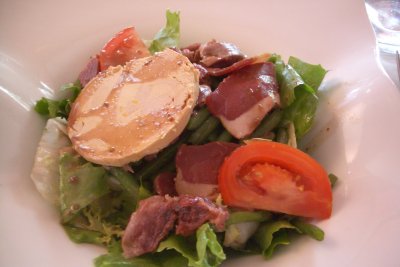
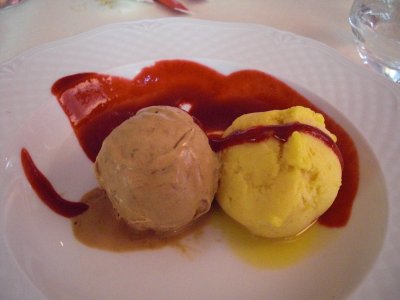 Lunch time came when we were only about 2/3 of the way through the exhibit, so we turned in our audioguides and went off in search of lunch. We spotted a promising place just across the street, but of course we had not brought our grappling hooks and climbing gear, so we had to walk the long way around the moat. The restaurant was called the Tannay, which turns out to be a town and canton (county?) in western Burgundy; we had just skirted the northern edge of it on our way to buy gas in Clamecy. We were the only indoor customers, and only one other party sat outside (in the full sun, as is the European custom). We both ordered salads of greens, tomatoes, cold green beans, foie gras, magret (duck ham), and confit duck gizzards, and I finished up with a dish of coffee ice cream and mango sorbet with raspberry sauce. Yum.
Lunch time came when we were only about 2/3 of the way through the exhibit, so we turned in our audioguides and went off in search of lunch. We spotted a promising place just across the street, but of course we had not brought our grappling hooks and climbing gear, so we had to walk the long way around the moat. The restaurant was called the Tannay, which turns out to be a town and canton (county?) in western Burgundy; we had just skirted the northern edge of it on our way to buy gas in Clamecy. We were the only indoor customers, and only one other party sat outside (in the full sun, as is the European custom). We both ordered salads of greens, tomatoes, cold green beans, foie gras, magret (duck ham), and confit duck gizzards, and I finished up with a dish of coffee ice cream and mango sorbet with raspberry sauce. Yum.
When we once more presented ourselfs at the entrance to the exhibit to reclaim our guides, the staff seemed surprised (but pleased!) that we had some back for more. We could have spent hours more if we had actually watched and listened to all that was offered, and we certainly learned a huge amount about De Gaulle and his times (Jean Moulin surfaced again, meeting with De Gaulle during the German occupation of France), but in mid-afternoon, we decided it was time to go look at maquettes. At the Vauban museum, we had been reminded that scale models of some of his fortifications were on display in the national collection at the army museum. We'd seen the collection, many years before on our first visit to the museum, but we thought it was time to go again. Unfortunately, they are displayed in the "combles"—the space just under the roof—where elevators (and air conditioning) fear to tread, but the stairs to them were right there next to De Gaulle, so we started climbing and eventually reached the French fourth floor (what we would call the fifth, and remember that we started from the basement), where the models, 20 or 30 of them, are displayed in sealed plexiglas boxes under dim light.

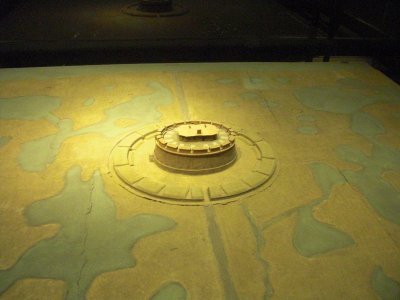 Most of the models are antiques in their own right, having been made when the fortifications were built, as early as the 15th century, and some are huge—I had forgotten that one of them is larger than our livingroom and wished I'd thought to bring my binoculars. At the left is the magnificent model of the equally magnificent Château Trompette in Bordeaux. We've been there, and walked all over the site, but unfortunately the fort isn't there any more. It was leveled and replaced by the vast Esplanade des Quinconces long before we ever visited France. Right next to it is the small model of the dimunitive Fort Pâté (so called, even in the museum's labels, because of its shape) on the Île d'Oleron, just off the coast of France near Rochefort.
Most of the models are antiques in their own right, having been made when the fortifications were built, as early as the 15th century, and some are huge—I had forgotten that one of them is larger than our livingroom and wished I'd thought to bring my binoculars. At the left is the magnificent model of the equally magnificent Château Trompette in Bordeaux. We've been there, and walked all over the site, but unfortunately the fort isn't there any more. It was leveled and replaced by the vast Esplanade des Quinconces long before we ever visited France. Right next to it is the small model of the dimunitive Fort Pâté (so called, even in the museum's labels, because of its shape) on the Île d'Oleron, just off the coast of France near Rochefort.
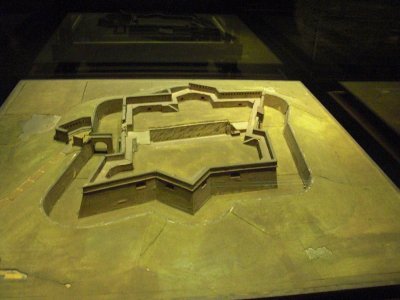
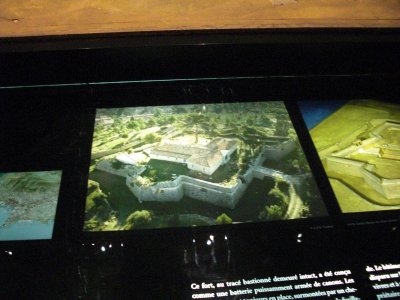 At the left here is the model (somewhat simplified, we are told) of a fort near the coast somewhere in the south of France, when is was in fighting trim. At the right is a modern photograph of the site now that it is private property and has a house in the middle.
At the left here is the model (somewhat simplified, we are told) of a fort near the coast somewhere in the south of France, when is was in fighting trim. At the right is a modern photograph of the site now that it is private property and has a house in the middle.
At one point in the afternoon, shifting my coast and purse from one shoulder to the other, I managed to drop my new digital camera from a height of about 4 ft onto the stone floor, but amazingly no harm seems to have been done. Not a mark on it, the screen didn't crack, and the photos taken afterward look just as good as those from before. Whew.
Friday evening came our last dinner in France, and we had 8 p.m. reservations at Chez l'Ami Jean, a modest (but highly rated) Basque place that we remembered fondly from previous visits, as easy walk from our hotel. David suggested we set out early, so as to enjoy another stroll and apperitif in the rue Cler but then, as we walked, asked whether I remembered any bars or cafés nearer the restaraunt, to simplify the timing. I didn't remember enough about the area, but it was close enough that we decided to walk over to look—if we struck out, we could always come back to the rue Cler. We did find a caf&ecute; on the corner of the rue Malar, half a block from the restaurant, but David said, "let's just check out the restaurant; maybe they've already started serving." I rolled my eyes—David's always in favor of jumping our reservation time, whereas I find showing up early vaguely embarrassing (though I'm not sure why; most French restaurants don't plan to turn the tables during the evening). A glance revealed that, yes, they were serving; several tables were occupied, so we presented ourselves 45 minutes early, much to David's relief, as he was worried about that 7:30 a.m. departure time the next day.
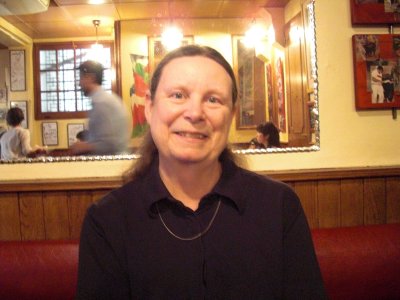
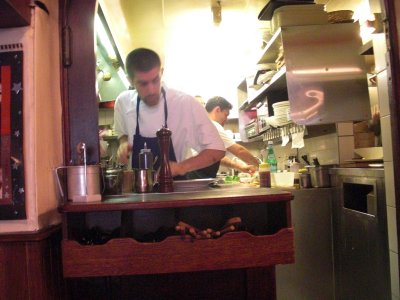 Here I am, seated at our table, my back to the wall and my head masking David's reflection in the mirror behind me. We were seated next to the kitchen door, so I had a good view through the pass. The guy on the right, in the background, is the head chef. Over my left shoulder in the photo, you can see part of a photo of a guy in white being gored from behind by a bull. (Basque bullfights are bloodless in the sense that the only blood ever shed is human; the bull is armed, but the matador is not.) David looked at the photo and at our waiter and asked whether that was him. I thought he was joking, but the waiter replied that it was, showing us by gesture where the horn went in and where it came out here, in the front ("but I'm all healed up now"). He even called to the other waiter, "hey, this guy recognized me in the photo!" I'm still not sure just who, if anybody, was putting who on.
Here I am, seated at our table, my back to the wall and my head masking David's reflection in the mirror behind me. We were seated next to the kitchen door, so I had a good view through the pass. The guy on the right, in the background, is the head chef. Over my left shoulder in the photo, you can see part of a photo of a guy in white being gored from behind by a bull. (Basque bullfights are bloodless in the sense that the only blood ever shed is human; the bull is armed, but the matador is not.) David looked at the photo and at our waiter and asked whether that was him. I thought he was joking, but the waiter replied that it was, showing us by gesture where the horn went in and where it came out here, in the front ("but I'm all healed up now"). He even called to the other waiter, "hey, this guy recognized me in the photo!" I'm still not sure just who, if anybody, was putting who on.
The restaurant is of much the same style as La Regalade—loud, busy, informal, and crowded. Once we were seated, we looked around and were puzzled to see that all the other diners in the place, every single one of them (perhaps 20 people at four or five tables), was Asian. What was up with that? I could see that one of the cooks was Asian; had she clued in her friends and family that you could easily get a table if you showed up at 6:30 p.m.? But the young woman dining alone at the table next to us seemed to be American and not to speak French. Maybe Asians in Paris just like to dine early? Or like Basque food? The people who came in after us seemed to be of the usual demographic mix (though with a higher precentage of tourists than at La Regalade, because of the location).
Chez l'Ami Jean has a "normal" à la carte menu, but we've always gone for the option that works like the menu at La Regalade—three-course dinner for a fixed price, with several choices for each course. This year the price had gone up from 32 to 35 euros. The Amuse-bouche, no matter what you order, is always a basket of bread and a spread of cooked white beans mashed with olive oil and yogurt or fromage blanc.

 First course, David: A boat-shaped slice of toasted country bread balanced on a thick slice of tomato and draped with slices of salt-cured raw salmon, all dressed with a nice vinaigrette.
First course, David: A boat-shaped slice of toasted country bread balanced on a thick slice of tomato and draped with slices of salt-cured raw salmon, all dressed with a nice vinaigrette.
First course, me: Lamb sweetbreads described as a "sautéed salad with the flavors of early summer, spice cage." I never figured out what they meant by "spice cage," but the sweetbreads and the little salad they rested on were excellent. I had just had veal sweetbreads a couple of times, so this was the best opportunity I'd ever had actually to compare them. The lamb ones differed from the veal ones in about the way lamb differs from veal—they had a slightly darker, gamier taste. I love both. The streaky garnish on top is crisply fried pork belly.

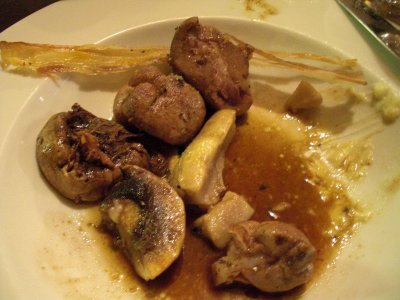 Main course, David: A concoction described on the menu as a "big vulgar gourmandise of potato stuffed with piglet." It was, in fact, a large potato, split and slightly hollowed out, sandwiching tender braised baby pork. On the side, spears of exceptionally flavorful white asparagus bundled with a slice of pork belly. Partway through, David said wistfully, "I thought this dish was going to be about the potato," but by the time he was finishing it, he said, "You know, I think it's about the potato after all."
Main course, David: A concoction described on the menu as a "big vulgar gourmandise of potato stuffed with piglet." It was, in fact, a large potato, split and slightly hollowed out, sandwiching tender braised baby pork. On the side, spears of exceptionally flavorful white asparagus bundled with a slice of pork belly. Partway through, David said wistfully, "I thought this dish was going to be about the potato," but by the time he was finishing it, he said, "You know, I think it's about the potato after all."
Main course, me: Veal kidneys, sautéed rare. The half-cylindrical object in the center of the plate is what's left of the large piece of marrow served with them. They were very good, but I found them hard to cut up, as the tough cores had not been trimmed closely enough.
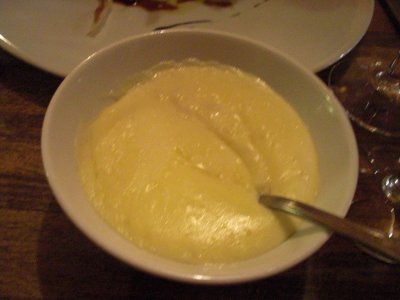
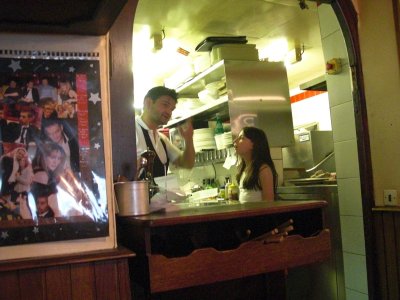 With the kidneys came this bowl of semiliquid, buttery mashed potato.
With the kidneys came this bowl of semiliquid, buttery mashed potato.
Partway through the service, the chef's daughter arrived, and he took time to chat, clown, and roughhouse with her for a few minutes, even chasing her out of the kitchen at one point, squealing with mock fear, with the blowtorch he was using to glaze somebody's crême brulée. By the time 8 p.m. rolled around, the place was packed, as it apparently always is, every night.

 Dessert, David: A raspberry vacherin, that is, two disks of crisp meringue sandwiched with ice cream and raspberries and garnished with grilled pistachios and almonds. I don't know what the delicious yellow liquid is that comes with the nuts; I would have said melted butter, but I noticed that it didn't congeal when it touched something cold. Some sort of nut oil, maybe?
Dessert, David: A raspberry vacherin, that is, two disks of crisp meringue sandwiched with ice cream and raspberries and garnished with grilled pistachios and almonds. I don't know what the delicious yellow liquid is that comes with the nuts; I would have said melted butter, but I noticed that it didn't congeal when it touched something cold. Some sort of nut oil, maybe?
Dessert, me: The restaurant's famous rice pudding, drizzled with a spiral of condensed milk and served, as usual, by the quart but not with the cinnamon whipped
cream of previous years; instead, it came with dairy caramel, as at La Regalade. I would say that the rice pudding wasn't quite up to the standard of previous years—the rice was a little harder and the dish not so creamy. The salty, creamy caramel, on the other hand, was a definite wow! David kept stealing spoonfuls of it; fortunately there was plenty. I've mastered a pretty good immitation of the rice pudding at home; now I have to work on that caramel!
Surprisingly, we got mignardises (unexpected in a restaurant of this style)—three large, square house-made marshmallows, visible behind my rice-pudding bowl.
previous entry
List of Entries
next entry

 The Invalides is a huge complex (it has, count 'em, 15 interior courtyards) built in the 17th century by Louis XIV as a veterans' hospital and retirement home (hence its official name "hôpital des invalides"). It was suburban at the time but is now pretty much in the middle of the city, between the Eiffel Tower and the Louvre. Louis included both a full-size church (St. Louis des Invalides), at which daily attendance was compulsory for the veterans, and a private chapel for his own use, under the large dome. The view on the left is of the dome, regilded in 1989 for the bicentennial of the revolution, as we saw it when approaching on foot, on the inland side. The one on the right, taken from the river side, is from a film we were shown in the De Gaulle exhibit. (The keyhole-shaped green space at the left edge of the aerial view is the garden of the nearby Rodin museum, well worth a visit as well.)
The Invalides is a huge complex (it has, count 'em, 15 interior courtyards) built in the 17th century by Louis XIV as a veterans' hospital and retirement home (hence its official name "hôpital des invalides"). It was suburban at the time but is now pretty much in the middle of the city, between the Eiffel Tower and the Louvre. Louis included both a full-size church (St. Louis des Invalides), at which daily attendance was compulsory for the veterans, and a private chapel for his own use, under the large dome. The view on the left is of the dome, regilded in 1989 for the bicentennial of the revolution, as we saw it when approaching on foot, on the inland side. The one on the right, taken from the river side, is from a film we were shown in the De Gaulle exhibit. (The keyhole-shaped green space at the left edge of the aerial view is the garden of the nearby Rodin museum, well worth a visit as well.) Nowadays, the complex divided up into several uses. Part of it (far right corner in the aerial view) is still a veterans' hospital. St. Louis is still a church, but I don't know whether services are still conducted regularly there or whether attendance is still compulsory. The chapel under the dome now houses Napoleon's grandiose tomb and those of some other war heros. The rest is divide between the enormous army museum and the museum of contemporary history. I'm not sure which the De Gaulle "historial" is part of. The largest courtyard, in the center, is the location of the hysterical abduction-of-the-bride scene, with the horse guards and the helicopter, in the finale of The Mad Adventures of Rabbi Jacob. Netflix must surely have it.
Nowadays, the complex divided up into several uses. Part of it (far right corner in the aerial view) is still a veterans' hospital. St. Louis is still a church, but I don't know whether services are still conducted regularly there or whether attendance is still compulsory. The chapel under the dome now houses Napoleon's grandiose tomb and those of some other war heros. The rest is divide between the enormous army museum and the museum of contemporary history. I'm not sure which the De Gaulle "historial" is part of. The largest courtyard, in the center, is the location of the hysterical abduction-of-the-bride scene, with the horse guards and the helicopter, in the finale of The Mad Adventures of Rabbi Jacob. Netflix must surely have it. We entered the building just to the right of the dome (you can only get in a couple of ways, because most of the complex is surrounded by this picturesque dry moat, full of blooming yellow hawkweed that day), then hiked the length of the building, to the near left corner of the largest courtyard, then down a flight of stairs to the De Gaulle exhibit. We had the show almost to ourselves; only about three other people came and went while we were there.
We entered the building just to the right of the dome (you can only get in a couple of ways, because most of the complex is surrounded by this picturesque dry moat, full of blooming yellow hawkweed that day), then hiked the length of the building, to the near left corner of the largest courtyard, then down a flight of stairs to the De Gaulle exhibit. We had the show almost to ourselves; only about three other people came and went while we were there.
 Lunch time came when we were only about 2/3 of the way through the exhibit, so we turned in our audioguides and went off in search of lunch. We spotted a promising place just across the street, but of course we had not brought our grappling hooks and climbing gear, so we had to walk the long way around the moat. The restaurant was called the Tannay, which turns out to be a town and canton (county?) in western Burgundy; we had just skirted the northern edge of it on our way to buy gas in Clamecy. We were the only indoor customers, and only one other party sat outside (in the full sun, as is the European custom). We both ordered salads of greens, tomatoes, cold green beans, foie gras, magret (duck ham), and confit duck gizzards, and I finished up with a dish of coffee ice cream and mango sorbet with raspberry sauce. Yum.
Lunch time came when we were only about 2/3 of the way through the exhibit, so we turned in our audioguides and went off in search of lunch. We spotted a promising place just across the street, but of course we had not brought our grappling hooks and climbing gear, so we had to walk the long way around the moat. The restaurant was called the Tannay, which turns out to be a town and canton (county?) in western Burgundy; we had just skirted the northern edge of it on our way to buy gas in Clamecy. We were the only indoor customers, and only one other party sat outside (in the full sun, as is the European custom). We both ordered salads of greens, tomatoes, cold green beans, foie gras, magret (duck ham), and confit duck gizzards, and I finished up with a dish of coffee ice cream and mango sorbet with raspberry sauce. Yum.
 Most of the models are antiques in their own right, having been made when the fortifications were built, as early as the 15th century, and some are huge—I had forgotten that one of them is larger than our livingroom and wished I'd thought to bring my binoculars. At the left is the magnificent model of the equally magnificent Château Trompette in Bordeaux. We've been there, and walked all over the site, but unfortunately the fort isn't there any more. It was leveled and replaced by the vast Esplanade des Quinconces long before we ever visited France. Right next to it is the small model of the dimunitive Fort Pâté (so called, even in the museum's labels, because of its shape) on the Île d'Oleron, just off the coast of France near Rochefort.
Most of the models are antiques in their own right, having been made when the fortifications were built, as early as the 15th century, and some are huge—I had forgotten that one of them is larger than our livingroom and wished I'd thought to bring my binoculars. At the left is the magnificent model of the equally magnificent Château Trompette in Bordeaux. We've been there, and walked all over the site, but unfortunately the fort isn't there any more. It was leveled and replaced by the vast Esplanade des Quinconces long before we ever visited France. Right next to it is the small model of the dimunitive Fort Pâté (so called, even in the museum's labels, because of its shape) on the Île d'Oleron, just off the coast of France near Rochefort.
 At the left here is the model (somewhat simplified, we are told) of a fort near the coast somewhere in the south of France, when is was in fighting trim. At the right is a modern photograph of the site now that it is private property and has a house in the middle.
At the left here is the model (somewhat simplified, we are told) of a fort near the coast somewhere in the south of France, when is was in fighting trim. At the right is a modern photograph of the site now that it is private property and has a house in the middle.
 Here I am, seated at our table, my back to the wall and my head masking David's reflection in the mirror behind me. We were seated next to the kitchen door, so I had a good view through the pass. The guy on the right, in the background, is the head chef. Over my left shoulder in the photo, you can see part of a photo of a guy in white being gored from behind by a bull. (Basque bullfights are bloodless in the sense that the only blood ever shed is human; the bull is armed, but the matador is not.) David looked at the photo and at our waiter and asked whether that was him. I thought he was joking, but the waiter replied that it was, showing us by gesture where the horn went in and where it came out here, in the front ("but I'm all healed up now"). He even called to the other waiter, "hey, this guy recognized me in the photo!" I'm still not sure just who, if anybody, was putting who on.
Here I am, seated at our table, my back to the wall and my head masking David's reflection in the mirror behind me. We were seated next to the kitchen door, so I had a good view through the pass. The guy on the right, in the background, is the head chef. Over my left shoulder in the photo, you can see part of a photo of a guy in white being gored from behind by a bull. (Basque bullfights are bloodless in the sense that the only blood ever shed is human; the bull is armed, but the matador is not.) David looked at the photo and at our waiter and asked whether that was him. I thought he was joking, but the waiter replied that it was, showing us by gesture where the horn went in and where it came out here, in the front ("but I'm all healed up now"). He even called to the other waiter, "hey, this guy recognized me in the photo!" I'm still not sure just who, if anybody, was putting who on.
 First course, David: A boat-shaped slice of toasted country bread balanced on a thick slice of tomato and draped with slices of salt-cured raw salmon, all dressed with a nice vinaigrette.
First course, David: A boat-shaped slice of toasted country bread balanced on a thick slice of tomato and draped with slices of salt-cured raw salmon, all dressed with a nice vinaigrette.
 Main course, David: A concoction described on the menu as a "big vulgar gourmandise of potato stuffed with piglet." It was, in fact, a large potato, split and slightly hollowed out, sandwiching tender braised baby pork. On the side, spears of exceptionally flavorful white asparagus bundled with a slice of pork belly. Partway through, David said wistfully, "I thought this dish was going to be about the potato," but by the time he was finishing it, he said, "You know, I think it's about the potato after all."
Main course, David: A concoction described on the menu as a "big vulgar gourmandise of potato stuffed with piglet." It was, in fact, a large potato, split and slightly hollowed out, sandwiching tender braised baby pork. On the side, spears of exceptionally flavorful white asparagus bundled with a slice of pork belly. Partway through, David said wistfully, "I thought this dish was going to be about the potato," but by the time he was finishing it, he said, "You know, I think it's about the potato after all."
 With the kidneys came this bowl of semiliquid, buttery mashed potato.
With the kidneys came this bowl of semiliquid, buttery mashed potato.
 Dessert, David: A raspberry vacherin, that is, two disks of crisp meringue sandwiched with ice cream and raspberries and garnished with grilled pistachios and almonds. I don't know what the delicious yellow liquid is that comes with the nuts; I would have said melted butter, but I noticed that it didn't congeal when it touched something cold. Some sort of nut oil, maybe?
Dessert, David: A raspberry vacherin, that is, two disks of crisp meringue sandwiched with ice cream and raspberries and garnished with grilled pistachios and almonds. I don't know what the delicious yellow liquid is that comes with the nuts; I would have said melted butter, but I noticed that it didn't congeal when it touched something cold. Some sort of nut oil, maybe?